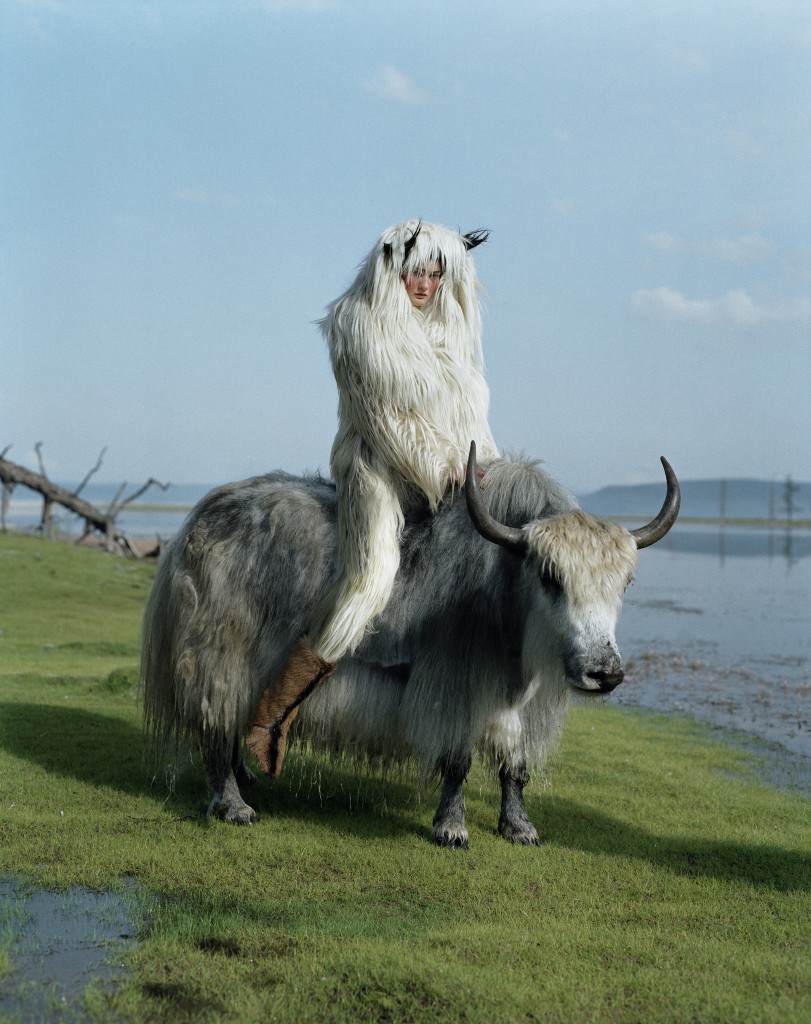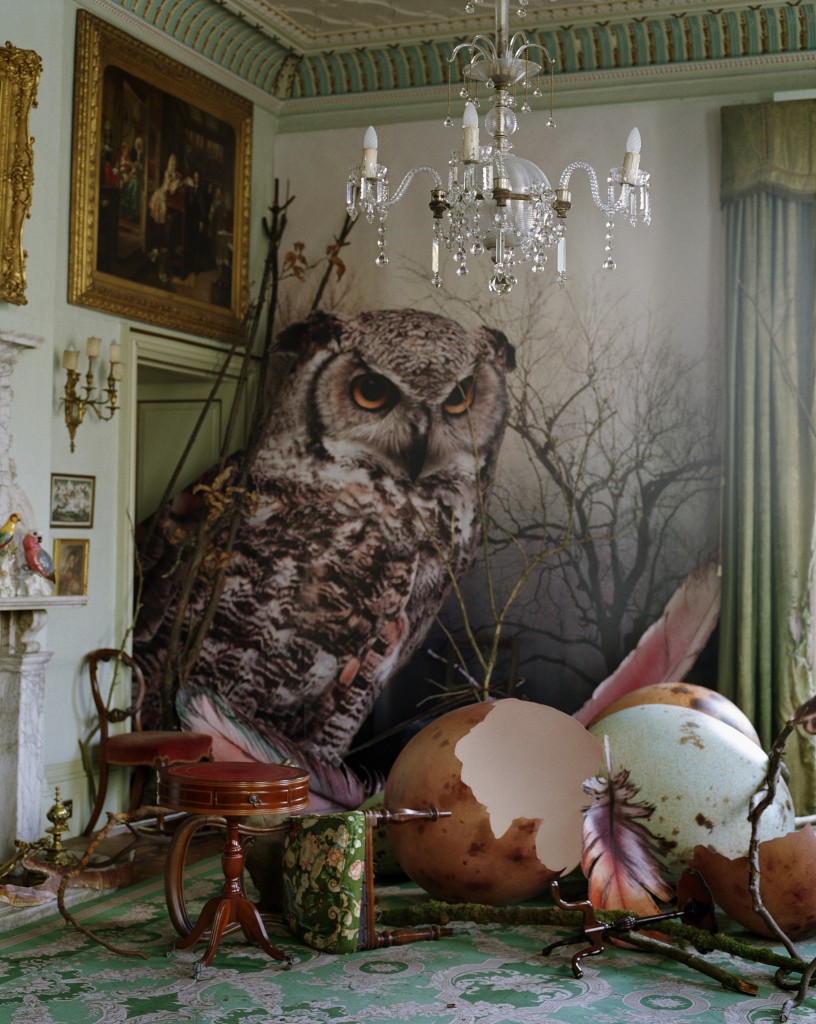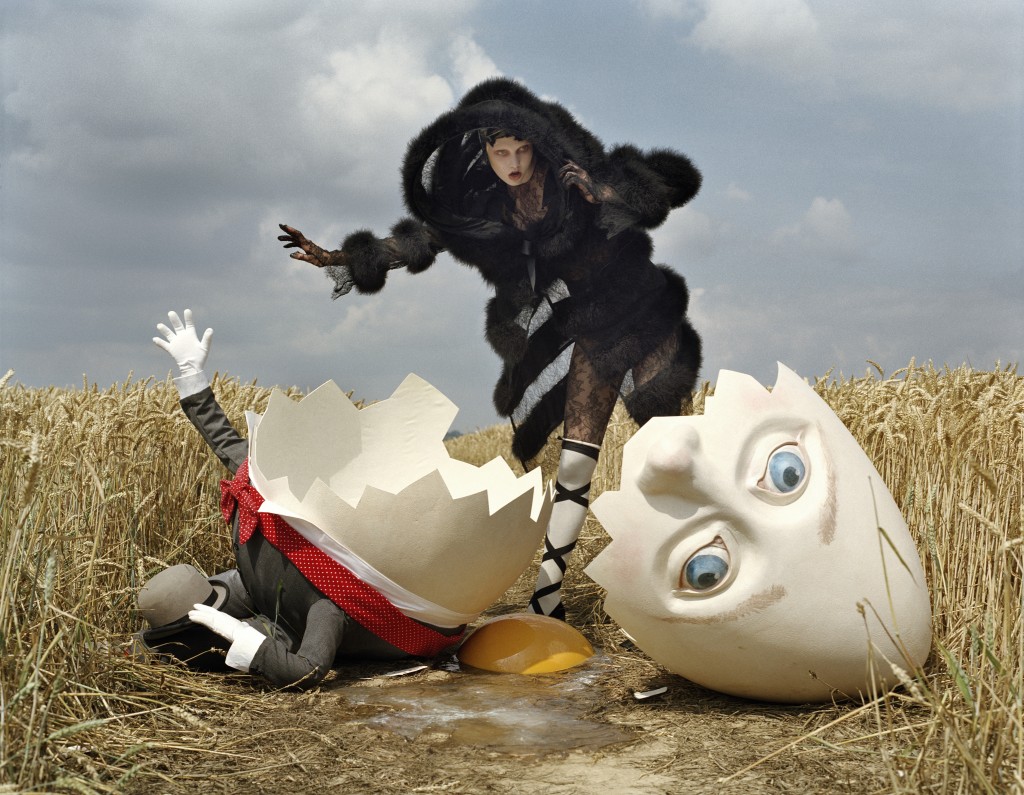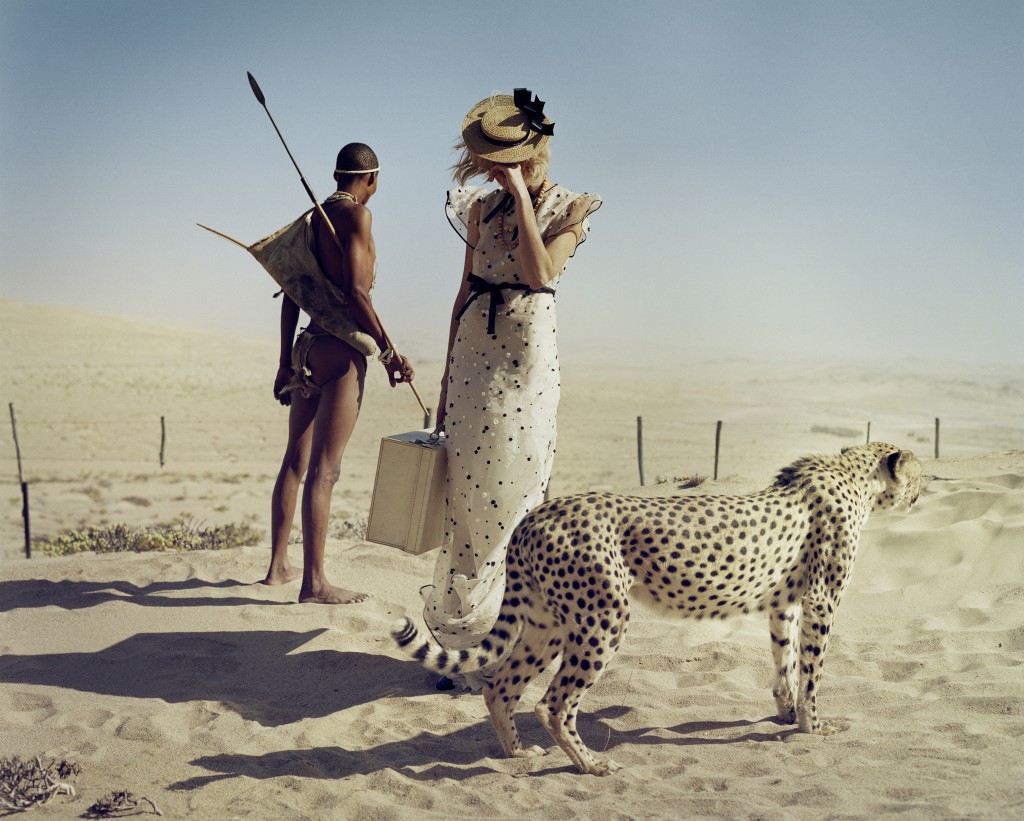 Michael Hoppen Discusses Tim Walker
Michael Hoppen Discusses Tim Walker
Interviewed by Andrea Blanch
What makes Tim unique?
Unique is a big, big word. “What makes Tim special?” is probably easier to answer. He’s not only a wonderful human being, but he’s also very generous and a real innovator. He makes things happen and, unlike a lot of photographers today who let the computer do a lot of the work, everything you see in one of Tim’s pictures is done in front of the camera. There is no Photoshop, no trickery.
None at all?
None at all. There is one picture in the new book where a little pipe is being retouched out, but 99.999 per cent of Tim’s pictures are exactly as they look in the can. There is no trickery. No Photoshop. He makes everything himself. Everything is set up. If it happens, if it moves, if it glows, if it slides, if it’s giant, if it’s miniature. You know that doll? . . . She is about 18-20 feet high.
From what I’ve heard, he’s going through a transition — from big productions to these simple white backgrounds. How has his production or distribution changed?
He’s always done what he does. The fact that he’s willing to release prints today is quite unusual. Until recently, he didn’t want to release his work in print form.
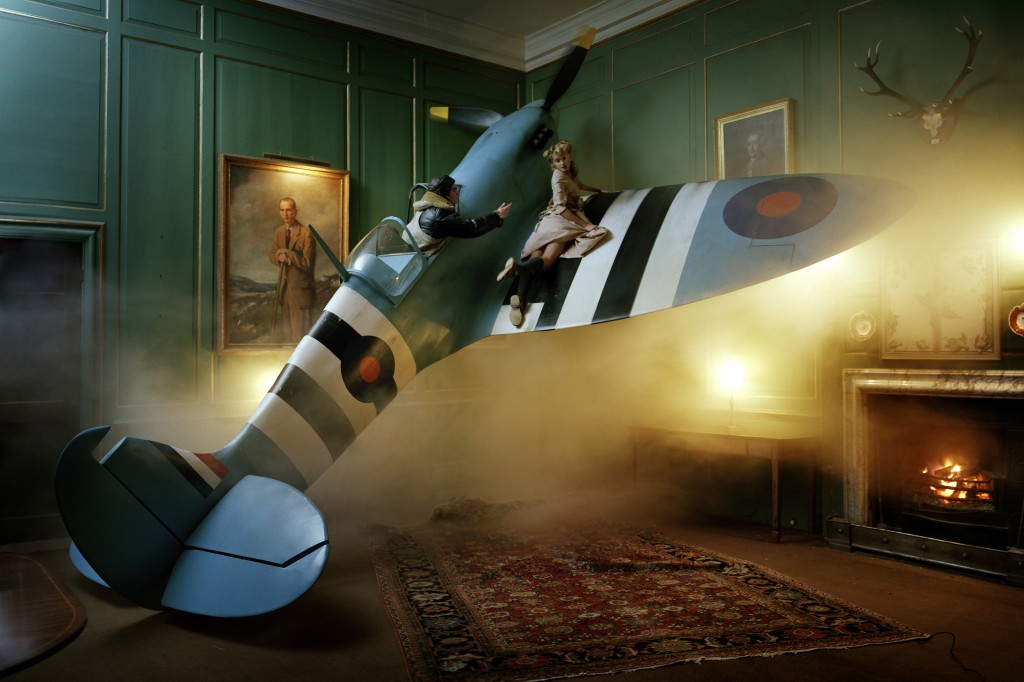
Tim worked with Richard Avedon. How does Tim’s work with the white background differ from Avedon’s?
did it in black and white on 10 x 8. Tim is doing it in bright, glorious color. I think there’s an element of Avedon up to a point in some of Tim’s work, where there’s drama and theater, but it’s so beautifully executed. It’s not forced. What the white backdrop is allowing Tim to do is examine detail in the subject’s face . . . Tim is interested in the longevity of character. This is why Avedon, Penn, and a lot of portrait photographers choose a simple backdrop. The eyes are not allowed to roam anywhere else. I think that’s almost a self-imposed discipline rather than somebody saying: "I want to copy somebody else.” Tim has become interested in people’s faces, expressions, the way they react to him. This is not a passing phase . . . I like the fact that he doesn’t risk his morals. He’s continuously pushing himself.
Tim is known as a storyteller. Don’t you think that all good photographs tell a story? What sets his story apart?
You just added the word, which of course is the most important word: all good photographs tell a story; not all photographs tell a story. Yes, I think you’re absolutely right, but how many good photographs are there in the world or how many good photographs could you or I take? Not many. I think people try to tell stories, even if it’s simply taking a picture of a family at Christmas. They’re trying to say: “We had a great time!” If you saw my Christmas photographs, it looks like a funeral . . . Tim manages to fill his photographs with stories and qualities and layers, which encourages people to question things, which is why we’re having this conversation.
Do you make any distinction between fine art photographers and fashion photographers?
Absolutely. I think Tim is an artist that a lot of fashion people have been able to hang their work on. In a sense, it’s a stage set. Tim’s imagination is there. Set designers and certain people in fashion like to bring their stories. When you talk to a designer they’ll talk about their ‘winter collection’, and I like that conversation. It’s similar. Now, I’m not comparing Tim to Irving Penn in any way, but when you read and hear about the stories and letters between Issey Miyake and Irving Penn . . . it is a confluence of ideas and minds coming together. Tim needs great imagination from a fashion designer and they need great imagination from Tim. If it works, what you end up with is a wonderfully beautiful — and also informative — picture which goes beyond simply selling the coat or selling the handbag, which, I’m afraid to say is what a lot of fashion photography is all about today . . . I’m not moralizing it, but I’m saying I don’t think that’s Tim’s style.
There are fine art photographers who do fashion campaigns or fashion editorials. Here, it’s easier to go from being a fine art photographer to fashion. Is it that way in Europe?
I think it’s exactly the same. We represent Sarah Moon and Guy Bourdin, both of whom have made that leap, as did Avedon. I think part of it is that the pictures in themselves are timeless and the product does not control the picture. The photographer’s signature controls the picture. That creates a distinction. Sometimes fashion photography is fine and, sometimes, 20 or 30 years after it’s taken it gets better than fine. Obviously, time will tell. But I do think one of the reasons that his work is so loved, and so collected, and so popular, is that he does not allow the fashion to control the picture.
Tim has done some film, do you see him going more in this direction?
No, it’s just a part of the way he expresses himself. I think he’s “visual,” to be honest. I don’t think he’s tied to anything. He doesn’t use photography as a crutch or as a cave. I think Tim is someone who likes to express himself and likes to do it in as many different and creative and positive ways as he can. But the consistency is so important. I’m sure you’d agree [that with a body of work] you just want to turn every page and be delighted. Not say: “Well, there was that one at the beginning and one at the end that I liked.” I think Tim’s way of being consistent is to challenge himself all the time.
Do you feel that, because of new technology, it’s important for artists to move into motion?
I think it would be a very sad state of affairs if everyone followed down that path. Everyone’s looking for something new, but . . . it’s what you do with [the technology] that’s really important . . . One of the strengths Tim has — it’s not his denial of technology, it’s the fact that he doesn’t feel he needs it. He doesn’t use it to ‘dress the mutton up as lamb,’ as we would say.
I think that’s so refreshing, I truly do.
That’s what I would title the article, “Tim is Refreshing.” . . . I think the greatest fashion photographer in the world today, unequivocally, is Viviane Sassen. Tim and I talk about her endlessly. She bucks all of the trends; she takes black people in the midday sun, in the heart of Africa, and lets their faces go dark, and creates a wonderful visual sculpture. Sarah Moon is another person I have great faith in. I’m not saying we won’t look at a lot of other fashion, but most of it is transitory. Every day, I get calls for Guy Bourdin from people who weren’t even born when he died. They come in here with their mouths on the floor thinking: ‘no Photoshop, nothing?’ I honestly think that Photoshop has done more damage to photography, in a way, than it has helped. It’s a quick fix, but as a creative tool, I think it prevents photographers from developing their own style. If every photographer pushes his or her work through the same program, there’s a limit to what it can look like. I like to see photographers hand-making things.
When I say the word fashion, what comes to mind?
My lack of it. I don’t know — I think, industry. I’ve never really thought about it. To me, fashion is something that’s passing, it’s transitory. Most of it is just stuff, isn’t it? Every now and again, something sweeps the ‘stuff’ aside and says ‘this is the milestone’ . . . I look for those markers.
What would your advice be to an emerging photographer today?
Give up. Give up, now! Quick! It’s a tough job out there. You’ve got to find your own signature. You’ve got to be able to say: ‘there’s no one else who could’ve taken that.’ Seriously, I say to most pros: ‘you’re heading into the great dark unknown and it’s an impossible job and you should look for something a little easier, like firefighting or something.’
You’re kidding, you really say that to people?
I do, I’m afraid. I think it’s one of the toughest things to be really good at. There are lots of people who make a fantastic living. It’s a great life being a photographer. If you simply want to make a living that’s one thing, if you want to create a legend or testament to your talent … I think if you’re conscious of that you’ll fail straight away. But, I think it’s an obsession. It’s something that has to fill your waking and sleeping hours. Most photographers will tell you that it’s an exhausting profession because every moment of the day that you’re using your eyes you're looking for that picture . . . but, for commercial photography, it’s not necessarily about looking, it’s about making money and who you’re working for. I think they’re two quite different things.
You left photography in 1991. Why?
Well, Guy Bourdin was always my guiding light, my shining light. I would always look and see what he was doing. When he died in ’91, I thought: ‘Well, I’m never going to make it. That’s it.’ So, I stopped and went home and said to my wife, ‘I’m going to open up a gallery.’ I think all of the years I spent being a photographer taught me how very, very difficult it is to do. The conversation we’re having now, we can only have because I tried to do it myself. I know how hard it is.
What makes a great photograph?
It has to change my point of view. Of course, quality, and all of the usual things, but the [defining] point is: does it change the way I think about something? Did I know that before, have I ever thought about it like that, have I ever looked at it like that, or is there something about this that is teaching me something? That’s what makes a great photograph. Wouldn’t you agree?
VIEW MORE OF TIM WALKER'S IMAGES & OTHERS IN MUSÉE Magazine No. 5 Vol. 1


